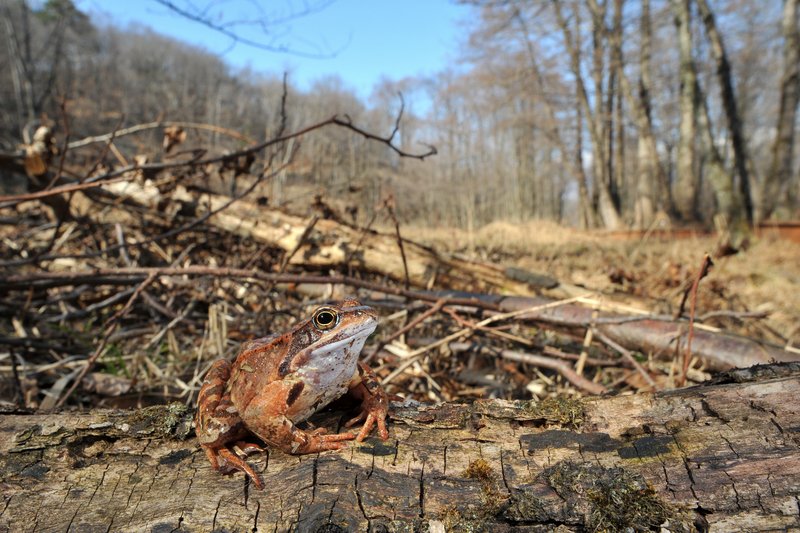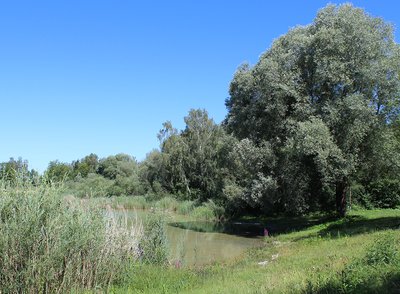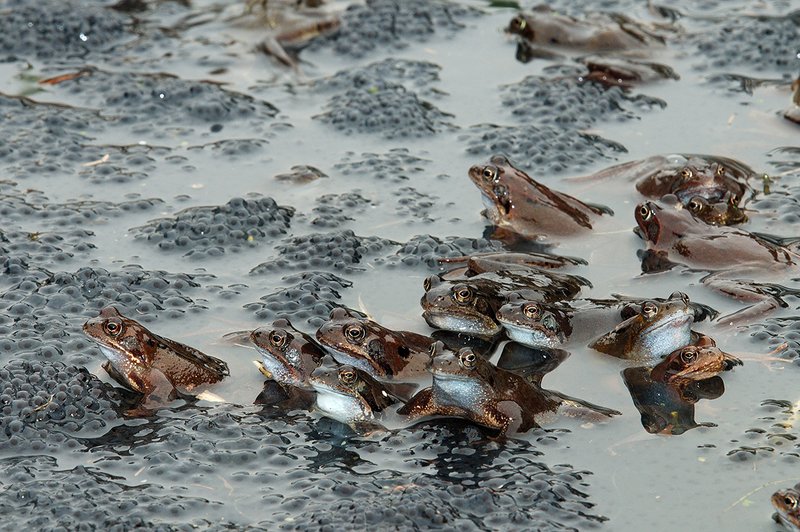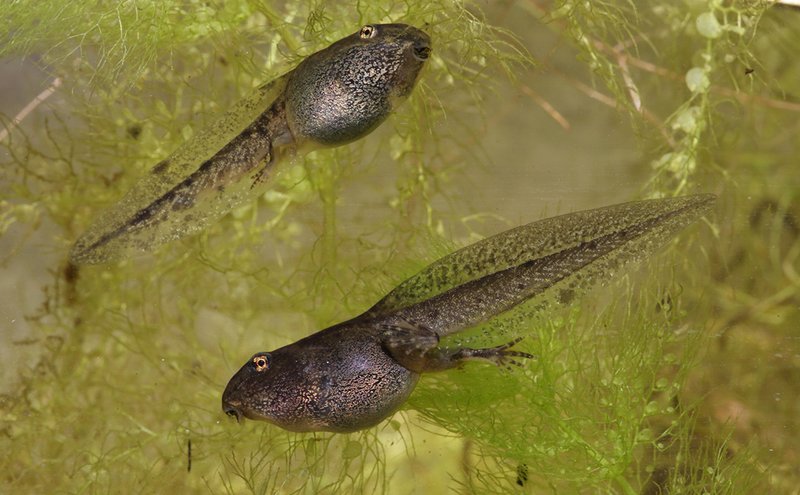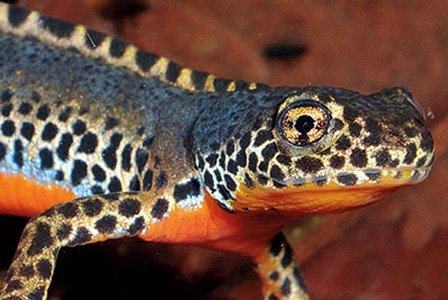The European grass frog (Rana temporaria), also known as the European common frog, is our most common amphibian species and is to be still to be found relatively often in Germany. It migrates in early spring to its spawning grounds, and spends the terrestrial phase mainly in thick grass and herbaceous vegetation in open countryside and sparse forests. Changes in fields and meadows, intensive agriculture and the fragmentation of habitats in particular, cause problems for this otherwise very undemanding amphibian. The result is that the grass frog is increasingly migrating to less compromised habitats in the forests. The forest is thus becoming more and more important as a habitat.
An inconspicuous creature
The grass frog (popularly also known as the “European pond frog” or “European brown frog”), together with the moor frog (Rana arvalis) and agile frog (Rana dalmatina), makes up the group of brown frogs within the genus Rana of the true frog family (Ranidae). Characteristic of this species is the distinctive dark spot on their temples, clearly visible behind the eye. Otherwise this blunt-snouted frog, which grows to a body length of up to 10 cm, is rather inconspicuous, varying in colour from greyish-brown to reddish-brown to olive green, often with dark blotches on the upper side. Its belly is usually light-coloured and mottled.
Distribution
The grass frog (Rana temporaria) is Europe’s most widespread amphibian species. The distribution area of this “commonplace” species stretches from the Cantabrian mountains on the Iberian peninsula in the west, and deep into Russia, across the lowland plains of western Siberia. By contrast, it is not usually to be found in the Mediterranean region. The range of the grass frog stretches further to the north than that of any other amphibious species. It is the only amphibian species to inhabit the North Cape.
In Germany the grass frog is to be found throughout the country, from the islands of the North and Baltic Seas to the Alps. The highest spawning ground known to be used in the Alps by the grass frog is at 2.775 m above sea level in the Swiss canton of Graubünden. Changes in the landscape resulting from human activity do however mean that, despite its widespread distribution throughout Germany, there are stark regional differences in the density of its distribution and in its population numbers.
Habitat
The grass frog is still relatively common in Bavaria. Its wide distribution is also reflected in the broad spectrum of habitats it lives in. It is difficult to specify its habitat requirements, as the species uses all sorts of both stagnant and flowing bodies of water as spawning sites. Most grass frogs are found in the mating season in permanent, stagnant bodies of water such as ponds and small pools. It does however also use calmer, slowly flowing waters such as ditches and streams. It tends to avoid water bodies with high stocks of fish and fast-flowing waters, on the other hand, and only uses these where the choice of spawning site is limited. For spawning, it prefers predominantly shallow waters in sunny riparian zones with adequate vegetation. True to its name, the grass frog shelters mainly in dense grass and herbaceous vegetation in the summer months, unlike many other amphibians, which take refuge among stones or old wood. It finds this vegetation in open countryside on fallow areas, in field copses, along structured forest edges or within sparse areas of forest. As soon as it rains, grass frogs also head for sites with sparser vegetation in search of food.
The frog is frequently drawn back to suitable areas of water to hibernate - often the spawning sites of the spring - where it holds out on the waterbed. If the ice cover persists too long on stagnant waters, it is not unusual for grass frogs to suffocate. In many places, there is competition for oxygen-rich flowing waters and stagnant water bodies with a permanent supply of fresh water. A proportion of the animals hibernate in burrows and other frost-free hiding places.
Mating and reproduction
The brown frog group is thought to be particularly resistant to the cold. This is reflected in the early start to their activity in spring. As soon as the microclimatic conditions are favourable, from as early as the end of January, grass frogs migrate - often in their thousands - to their spawning sites, assuming they have not already spent the winter there. If temperatures remain above 5°C and the nights are frost-free, mating may take place as early as February. The main spawning season is however in March, with each female laying a gelatinous cluster of 800 to 2.500 eggs, depending on her size. The clusters of spawn laid by many females often form floating “rafts” that may be several square metres in area. The almost black larvae hatch after two to three weeks. Another two months later, the tadpoles finally mature into young frogs. This species is known as an “explosive spawner”, and stays only for a few days or weeks at the spawning site in spring before migrating back to its summer quarters.
Eating and being eaten
Grass frogs are predominantly active at dusk and night, but on rainy days will also venture out in search of food during the day. Depending on their terrestrial habitat, their diet is very diverse. Woodlice, mosquitoes, beetles, spiders, snails and worms may well be on the menu for this amphibian.
Their natural predators include various different animal species that eat them at both spawn and tadpole stage. In bodies of water inhabited by large numbers of newts, the chances of grass frogs developing are negligible. Birds - especially the mallard duck - also eat both the spawn and tadpoles. There are also some aquatic insects that prey on them, including diving beetles, dragonfly larvae and predatory water bugs. The growing tadpoles are viewed as potential prey by some predatory and non-piscivorous fish. Only a very small proportion of the larvae thus manage to develop into young frogs. On land the juvenile frogs often fall prey to all sorts of different bird species. Crows, birds of prey and herons all lie in wait for them on the banks. It is also not unusual for them to be eaten by shrews, polecats and moles.
Threats
Because of its wide distribution and relatively few requirements in terms of its habitats, the grass frog is considered to be a “commonplace” species. Nevertheless, its populations have declined in some parts of Europe in recent years. In many German states, including Bavaria, the grass frog thus appears on the “early warning” list of species. In some states, including Mecklenburg-Vorpommern, Berlin and Brandenburg, this amphibian is already classed as “endangered”.
The main reasons for this are intensive agriculture and the soil eutrophication caused by the excessive use of fertilisers. The intensification of land use in recent decades has led to an increasing loss of suitable habitats and habitat structures, and thus to a decline in amphibian populations. In a study commissioned in 2013 by the German Environmental Agency (Umweltbundesamt), scientists investigated the effects of various pesticides on grass frogs. Like many other amphibious species, grass frogs use arable land and fields as their living quarters in summer, and as migration corridors to their spawning sites in spring. As a result, their particularly sensitive bare skin may well be exposed to pesticides sprayed on the fields. The researchers found that with some pesticides, even one tenth of the permissible application rate is life-threatening for the amphibians.
Aside from intensive agriculture, sinking levels of groundwater and the associated drying up of surface water also contribute to the loss of potential spawning sites. Finally, settlement and road construction is leading to a fragmentation of the landscape and thus also of the migration corridors of grass frogs. Particularly in spring, as they migrate towards their spawning sites, many grass frogs are killed on the roads.
Protective measures in the forest
In the absence of a species-specific protection concept, the grass frog usually benefits only from general amphibian protection measures aiming to preserve terrestrial habitats and aquatic spawning sites. Forestry can help this species, especially by minimising damage to the forest floor during forestry operations, by promoting close-to-nature stands that are rich in deciduous trees, and by enhancing the supply of deadwood. Forest clearings and sparse structures in the stands create the grassy and herbaceous vegetation required by the frogs. Multi-layered, wide forest margins are important structures that link terrestrial habitats such as forests, wet meadows and fallow areas, and serve the grass frog and other amphibians as migration corridors.
In the course of road and trail maintenance and construction measures, small bodies of water and pools can be created along the trails, and amphibians also benefit if care is taken to minimise the impact on small animals during maintenance work on ditches and embankments. Where possible, a mosaic-like network of new small water bodies should be created within the migration range of an existing grass frog population. Water-filled ruts caused by vehicle and skidding tracks should not be filled up, as these can serve as temporary habitats.

